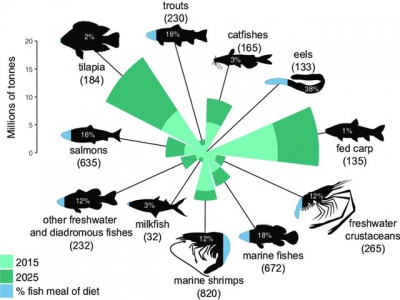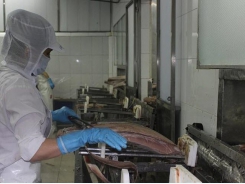How enzymes can improve aquafeed utilisation

Adding one enzyme to aquafeeds can improve their digestbility, while another enables a reduction in the levels of phosporous required in feeds, according to Daniel Arana, Natalia Soares and Rob Serwata from Huvepharma.
Global seafood production – including all species of fish, crustaceans and molluscs – is estimated at 179 million tonnes. According to the latest FAO statistics, aquaculture’s total contribution is around 114.5 million tonnes in live weight, of which aquatic animals represented 82.1 million tonnes1 (Fig 1).
Ensuring adequate food and nutrition security to a globally growing population is still a daunting challenge and aquaculture has a prominent role to play in world food security. Globally, food fish consumption has increased annually by around 3.1 percent, which is higher than all other animal proteins (such as meat, dairy and milk), which increased by 2.1 percent per year. On average, production of farmed aquatic animals has grown by 5.3 percent each year.

Figure 1: World aquaculture and capture fisheries production
Alongside aquaculture growth, the aquafeed markets have followed the same fast-growing trend. Recently, aquaculture feed production was estimated to be around 57 million tonnes.1 The split of the main species is dominated by carps, with approximately 28 percent; tilapia 18 percent; marine shrimp, 14.6 percent; catfish, 11.2 percent; marine fish, 8.1 percent; salmon, 6.9 percent; freshwater crustaceans, 4.6 percent; other freshwater fish 3.6 percent; trout 2.1 percent, others 2.9 percent (figure 2)2.
Holding a world leading position at the feed enzymes market, Huvepharma brings high efficiency enzymes, which are registered for aquaculture in some key countries, to the aquafeed sector.

Hostazym X: boosting feed digestibility
A highly efficient fibre-degrading enzymatic complex, which increases nutrient digestibility, resulting in better growth performance and a healthier gut environment. Hostazym X is the only fibre degrading enzyme approved by European Commission to be used in feed for carp species.
Aquaculture trials are often completed in environmental conditions that allow the full potential of a feed additive to be demonstrated.
To challenge Hostazym X, a trial was conducted at an outdoor facility at the University of Poznan, Poland. This trial allowed Hostazym X to be tested under adverse conditions, in contrast to previous research trials, water temperature fluctuated from 13.5 to 24.7 °C and dissolved oxygen ranged from 2.0-5.1 mg/l. Oxygen has a real impact on feed conversation ratio in fish and, when faced with a deficiency, fish growth and health are impacted.
The trial was set using three different concentrations of Hostazym X: 1050, 1500 and 3000 EPU/kg feed against a control feed. Twelve 40m2 ponds were each stocked with 20 x 375g fish and fed for 90 days. No mortalities were observed during the trial.
Hostazym X performance for all three levels of inclusion was better than the control. The results are presented in Table 1 and Figure 1 and clearly show that:
Body weight significantly increased compared to the control
Adjusted FCR decreased over control
Farmers who use Hostazym X get a better return on their investment
| Hostazym X treated feeds | ||||
| Parameter | Negative control | NC+1050 EPU | NC+1500 EPU | NC+3000 EPU |
| Final body weight g | 1191.5a | 1233.3b | 1236.4b | 1276.2b |
| Adjusted FCR* | 1.62 | 1.61 | 1.59 | 1.51 |
| SGR | 1.31 | 1.33 | 1.34 | 1.32 |
Table 1: Key growth parameters
* Adjusted FCR to control final body weight. Different superscripts represent statistical difference at p ≤0.05

Figure 3
Cost saving per 1000 metric tonnes of fish produced versus control
Optiphos: reducing phosphorous waste
Phosphorus is essential for all life and is required for optimum growth, feed efficiency and bone development in fish. Whilst an essential nutrient in aquaculture feed it also has an environmental impact and is responsible for eutrophication in many lakes and rivers.
The goal of sustainable aquaculture production is still far from being achieved, with fish retaining only ~40 percent of the phosphorous they consume in modern commercial fish feeds. Reduction of phosphorous levels in feed without impacting growth, feed efficiency and health is key to the development of low pollution diets. This is currently being achieved by the use of low-ash fishmeal or readily available phosphorous supplementation. However, there are other more cost-effective strategies – phytase enzymes that efficiently release unavailable phosphorous from the increasing inclusion of vegetable ingredients have a very important role to play.
Large amounts of organic phosphorous bound in phytic acid are present in modern day salmon and trout diets but these are poorly utilised. This represents an opportunity to utilise OptiPhos, a globally recognised phytase enzyme to help reduce the environmental impact of the salmonid industry.3
Fish feed contains high levels of vegetable protein sources (used as a replacement for fish meal), resulting in high levels of phytate in the feed. Phytase hydrolyses the phytate (phytic acid) and releases bound phosphorous, allowing significant financial savings by reducing the amount of inorganic phosphorous used. Additionally, the excretion of phosphorous into the environment is also significantly reduced.
Global salmon and trout production in 2020 stands at circa 3.2 million tonnes. This production is dominated by Atlantic salmon and over 50 percent of this is produced in Norway, while the other main players are in Chile, the UK, the Faroe Islands, Iceland, Ireland and Canada. Salmonid production, like that of most farmed animal species, does not have a great track record in terms of environmental impact, though huge efforts have been made by the industry to clean up its image.
The salmon industry in Norway produces ~1.24 million tonnes of salmon and ~1.65 million tonnes of salmon feed. This industry is also the third largest importer of inorganic phosphorous (P) (16,500 tonnes), even surpassing domestic phosphorous fertiliser usage.
Trails conducted on rainbow trout (Onchorhynchus mykiss) and Atlantic salmon (Salmo salar) demonstrated that phosphorus levels in the feed can be reduced significantly (range 2.5 – 3.5 g/kg) and that in some cases added inorganic P sources could be eliminated completely.
There are also financial benefits in implementing an OptiPhos strategy. Increasing digestible energy (DE) levels in salmonid feeds has a significant impact space in formulations. Competition for space can add significantly to formulation costs, so any opportunity to optimise space utilisation can provide a significant cost benefit.
OptiPhos, by reducing the necessity for phosphorous supplementation, can offer formulation cost savings of up to €15 per metric tonne, a win for both economic and environmental sustainability. This excludes any opportunity the farmer may have to increase production volumes and make better use of production biomass consents, which could be significant.
Figures 4 and 5 show the positive impact of OptiPhos in P retention and excretion in different trials with Atlantic salmon and rainbow trout.

Figure 4
Atlantic salmon P retention, excretion and reduction versus control using OptiPhos at 500 and 750 OTU/kg feed. All treatments relative to the control group had a statistical difference.

Figure 5
Rainbow trout P retention, excretion and reduction versus control using OptiPhos at 500 and 750 OTU/kg feed
Results presented in figures 4 and 5 clearly show:
- OptiPhos at 500-750 OTU/kg feed significantly reduces phosphorous discharge to environment in trout and salmon production systems.
- OptiPhos can significantly reduce the current usage of inorganic phosphorous in salmonid feeds.
- OptiPhos helps to minimise the environmental impact of salmonid aquaculture.
Có thể bạn quan tâm
Phần mềm

Phối trộn thức ăn chăn nuôi

Pha dung dịch thủy canh

Định mức cho tôm ăn

Phối trộn phân bón NPK

Xác định tỷ lệ tôm sống

Chuyển đổi đơn vị phân bón

Xác định công suất sục khí

Chuyển đổi đơn vị tôm

Tính diện tích nhà kính

Tính thể tích ao hồ



 Tackling sea lice in the face of climate…
Tackling sea lice in the face of climate…  Monitoring and handling congestion of fishery products exported…
Monitoring and handling congestion of fishery products exported…